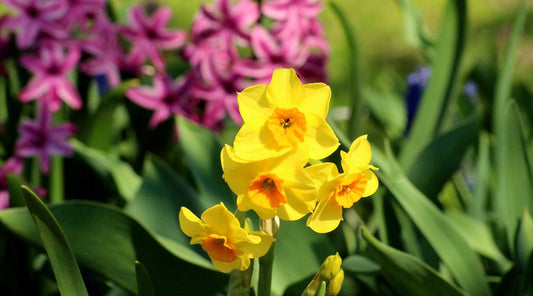Benefits of Shade-Loving Plants
Shade-loving plants are a fantastic addition to any garden, especially if you want to create a cooler environment. These plants are adapted to lower light conditions and can help reduce the overall temperature of your garden. By incorporating shade-loving plants, you can:- Cool down your garden: Plants that thrive in the shade can help lower the temperature around them, making your garden more comfortable during hot summer days.
- Support local wildlife: Many shade-loving plants provide food and shelter for birds, insects, and other wildlife, contributing to a healthier ecosystem.
- Improve soil health: Shade plants can help protect soil from erosion and retain moisture, which is crucial for maintaining soil health in shaded areas.
Top Shade-Loving Plants for Your Garden

- Hostas
- Hostas are known for their lush, broad leaves that come in various shades of green, blue, and even variegated patterns. They are low-maintenance and can thrive in deep shade.
- Care Tips: Water regularly to keep the soil moist, and divide the clumps every few years to promote healthy growth.
- Ferns
- Ferns are classic shade plants with delicate, feathery fronds that add a touch of elegance to any garden. They come in many varieties, each with its unique texture and shape.
- Care Tips: Keep the soil consistently moist and provide a layer of mulch to retain moisture and suppress weeds.
- Astilbes
- Astilbes are known for their vibrant, plume-like flowers that bloom in shades of pink, red, and white. They add a splash of color to shaded areas and are perfect for adding height to your garden beds.
- Care Tips: Plant in rich, well-draining soil and water frequently to keep the soil evenly moist.
- Heucheras
- Also known as coral bells, heucheras have striking foliage that comes in a wide range of colors, from deep burgundy to lime green. Their small, delicate flowers are a favorite of hummingbirds.
- Care Tips: Ensure good drainage to prevent root rot and provide some protection from harsh sunlight.
- Impatiens
- Impatiens are popular annuals that produce bright, cheerful flowers in a variety of colors. They are perfect for adding instant color to shaded garden beds and containers.
- Care Tips: Keep the soil moist and pinch back the stems to encourage bushier growth.
Designing a Shade Garden
Designing a shade garden can be a fun and creative process. Here are some tips to help you get started:- Plan your layout: Before you start planting, sketch out a plan of your garden. Consider the size and growth habits of each plant to ensure they have enough space to thrive.
- Combine textures and colors: Mix plants with different leaf shapes, sizes, and colors to create a visually appealing garden. For example, pair the broad leaves of hostas with the delicate fronds of ferns for contrast.
- Prepare the soil: Shade gardens often have different soil conditions than sunny areas. Amend the soil with compost or other organic matter to improve drainage and fertility.
- Use mulch: Mulch helps retain moisture, suppress weeds, and keep the soil cool. Apply a layer of mulch around your plants to help them thrive. Check out this post on fall mulching for more inspiration.
Maintenance Tips for Shade Gardens
Keeping your shade garden looking its best requires regular maintenance. Here are some tips to help you care for your plants:- Watering: Shade plants often need less water than sun-loving plants, but it's essential to keep the soil consistently moist. Check the soil regularly and water as needed.
- Pruning: Remove dead or damaged leaves and flowers to keep your plants healthy and encourage new growth.
- Fertilizing: Use a balanced, slow-release fertilizer to provide your plants with the nutrients they need. Be careful not to over-fertilize, as this can lead to lush foliage with few flowers.
- Pest control: Keep an eye out for common pests like slugs and snails, which can be particularly troublesome in shade gardens. Use organic pest control methods or traps to manage infestations.
Creative Ideas for Shade Gardens

- Garden features: Incorporate benches, water features, and decorative elements like statues or garden gnomes to create a relaxing and inviting space.
- Containers and vertical gardening: Use containers and vertical garden structures to add height and interest to your shade garden. This is also a great way to make the most of limited space.
- Paths and stepping stones: Create paths and stepping stones to make your garden more accessible and visually appealing. Use materials like gravel, wood chips, or natural stone to blend seamlessly with the garden's aesthetic.
Summer Gardening Tips for Shade Gardens
Keep your shade garden thriving during the hot summer months with these tips:- Watering: Deep watering is essential during the summer. Water early in the morning or late in the evening to minimize evaporation and ensure your plants get the moisture they need. Yard Butler has hose storage products for any home.
- Mulching: Mulch helps retain soil moisture and keeps the roots cool. Refresh your mulch layer regularly to maintain its effectiveness.
- Seasonal tasks: Prune and deadhead your plants regularly to encourage healthy growth and remove any diseased or damaged foliage. Check for pests frequently and address any issues promptly.
Conclusion
Shade-loving plants can transform your garden into a cool and inviting retreat. By carefully selecting and caring for these plants, you can create a lush, vibrant space that provides respite from the summer heat. Whether you're a seasoned gardener or a hobbyist, these tips and plant recommendations will help you make the most of your shaded areas. Happy gardening!________________________________________
With these tips and tricks, you'll be well on your way to creating a beautiful shade garden that will be the envy of your neighborhood. So, grab your gardening tools, get planting, and enjoy the cool, inviting oasis you've created!







